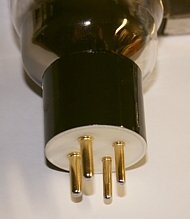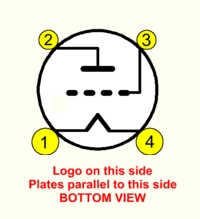EML 45B
Description
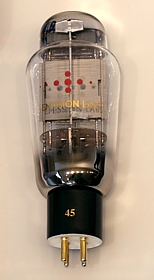 |
Features
|
About the 45 tube, 45B tube, and how to use it.
The 45B tube resulted from the many conversations I had with my friend Roger Modjeski, who unfortunately passed away in 2020. Roger spend his entire life and career on designing classical tube amplifiers, combining high output power with long tube life.
How to use the 45B instead of the 45.
Guarantee program for first owner.
At EML we have the normal guarantee. In addition to that, the first owner can register the tube within 4 weeks after receival, at the Emission Labs website, to participate in the 5 years guarantee program.
Register here for the 5years guarantee
EML 45B Filament Ratings |
|
| Filament Voltage | = 2.5Volt (AC or DC) |
| Tolerance on filament voltage | 5% |
| Filament Current | ~ 1.5Ampere |
| Maximum Time on Stand By (Heater voltage only) | 2 hours |
EML 45B Capacitance |
|
| Grid to Plate | |
| Grid to Filament | |
| Plate to Filament | |
EML 45B Maximum Conditions |
|
| Plate Voltage | |
| Plate Current | |
| Minimum Plate Dissipation | |
| Continuous Plate Dissipation | |
| Power Output in Class A | |
| Grid resistor | 500k Ohm |
EML 45B Factory Test conditions |
|
| Plate Voltage | |
| Plate Current | |
45B Recommended Single Ended operating points.
| ||||||||||||
Line | Vb | Ua | Rk | Ug |
Ia |
Ra |
Transformer |
P Tube |
P |
Damp. factor |
2nd harm. (%) |
Tube |
Ω |
See also note 2, 3, 4, 5 |
|||||||||||
| 1 | 331V |
275V |
1555Ω |
-56V |
36mA |
4k6 |
LL1663-40mA. 8Ω |
9.9W |
2W |
3.5 |
4.5% |
45, 45M, 45B Classic RCA circuit |
| 2 | 331V |
275V |
613Ω |
-46V |
75mA |
5k5 |
LL1620-080 4-8-16Ω |
20.8W |
2W |
6.4 |
0,72% |
|
.
|
||||||||||||
| 3 | 466V |
384 |
2000Ω |
-82V |
41mA |
9k2 |
LL1679-055 8-16Ω |
15.8W |
3.1W |
4.6 |
3.5% |
45B only. Note6 |
| 4 | 466V |
384 |
2000Ω |
-82V |
41mA |
6k5 |
LL9202-050 4-8-16Ω |
15.8W |
4W |
3.2 |
4.9% |
45B only. Note7 |
. |
||||||||||||
| 5 | 495V |
408V |
1800Ω |
-87V |
48mA |
9k2 |
LL1679-055 8-16Ω |
19.7W |
3.6W |
5.1 |
3.4% |
45B only. Note6 |
| 6 | 495V |
408V |
1800Ω |
-87V |
48mA |
6k5 |
LL9202-050 4-8-16Ω |
19.7W |
4.5W |
3.6 |
4.4% |
45B only. Note7 |
| 7 | 495V |
408V |
1800Ω |
-87V |
48mA |
5k |
LL1663-050 8Ω. |
19.7W |
5.2W |
2.7 |
5.6% |
45B only. Note8 |
| 8 | 495V |
408V |
1800Ω |
-87V |
48mA |
5k |
LL1663-050 8Ω. |
19.7W |
4.5W |
2.7 |
3% |
45B only. Note9 |
A final note about distortion:. Note10 .
|
||||||||||||
Credit: We want to thank our late friend Roger Modjeski, from the company RAM-LABS / Music Reference USA, for doing many detailed measurements on the 45B tube. It was shown, the published maximum distortion and maximum output power in this data sheet was achieved easily. Even so, the 45B seemed capable of doing more as published here. Thank you very much Roger. You will be remembered! |
||||||||||||
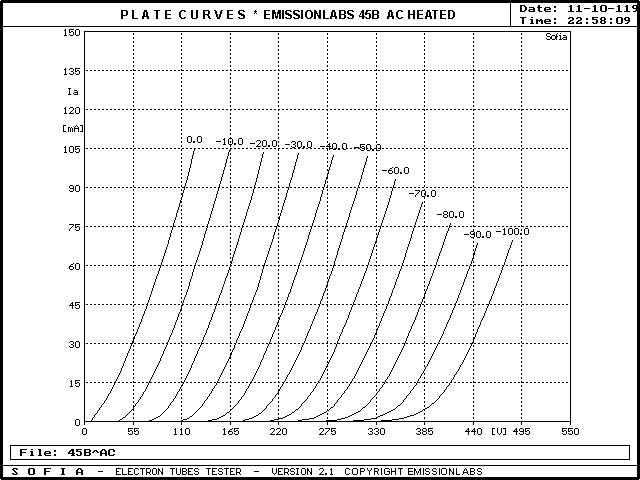
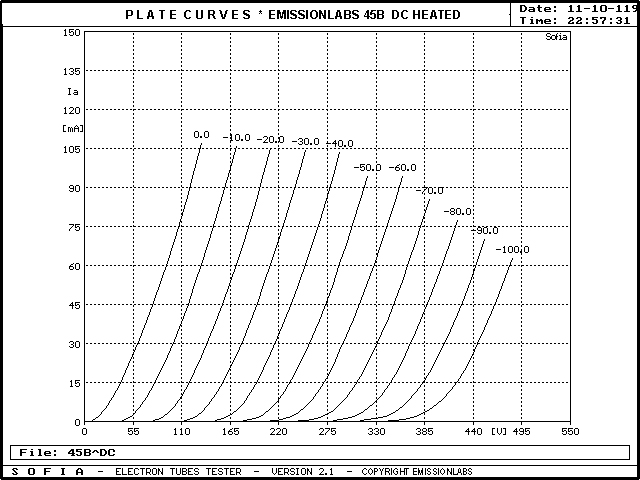
SPICE Parameters for circuit simulation |
EML 45B Mechanical Data |
|
|
Size including Socket 145 x 58 mm Weight of one tube: Pin 1: Heater1 |
Notes
- Note1) With tubes, miniaturization and linearity do not go together well. This is explained by electrical fields having specific behavior which does not follow the miniaturization exactly. With the EML45, the plate is larger than the historical 45, which large size contributes to lower distortion. This is documented by an external company, and they report 30% lower distortion compared to historical 45. Read here.
- Note2) Almost no distortion, and exceptional high damping factor. Ultimate circuit for back loaded horns, which need little power, but highest damping factor, to prevent muddy sound. Damping Factor is Ra/Rp. Here 6k/933. Proof of calculations here.
- Note4) Distortion drops considerably at lower signal. A distortion compare between two operating points should be made at the same output power.
- Note5) Transformer DC loss NOT included in Supply voltage. So depending on the chosen transformer, the Supply voltage needs to be chosen slightly higher, to compensate for the DC loss across the transformer.
- Note6) This working point gives superior results for all parameters, being: Output power, distortion and damping factor.
- Note7) This working point gives damping factor and distortion similar to the RCA circuits. Yet at higher output power.
- Note8) This working point is optimized for highest output power, at the compromise of damping factor. Distortion may seem high at 5.2 Watt, but this reduces drastically at lower output signal of 4.5 Watt. For this see Note 10.
- Note9) This is the same working point as above, and it demonstrates an amazing 30.4dB low distortion, yet at 4.5 Watt still. However damping factor is not very high. This would be a meaningful application for loudspeaker systems using an active bass, so damping factor plays no important role.
- Note10) As you see from the examples, there is no "best" working point. It is confusing if you were looking for that. You need to choose one, which suits your own needs best. Keep in mind, distortion is specified at full power for the working points, bit it drops exponential at lower power. A triode amplifier with 5% distortion at full power is considered very good, as distortion drops drastically at half of maximum power.

